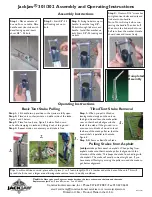
2
INSTRUCTIONS FOR UNLOADING YARD RAMPS
FROM FLATBED TRAILERS
If an overhead crane of sufficient capacity is not available, use a forklift with a minimum capacity rating
of 8,000 pounds to unload catalog listed yard ramps. Customers who purchase custom size yard ramps
which exceed the catalog sizes in width, length or rated capacity should seek a recommendation from Bluff
Manufacturing for forklift capacity due to additional weight.
A nylon sling of at least 48" in length is recommended. The sling may be of the “2 eye” or “endless”
configuration. A minimum capacity rating of 10,000 pounds for the basket method of lifting is recommended.
To lower the yard ramp onto its belly:
1. Create a solid stack of cement blocks or pallets that can hold the weight of the yard ramp during
assembly. This stack needs to be at least 48” high for installing the legs, and be able to support up to
8,000# for standard yard ramps of up to 30,000# capacity and 84” wide.
2. Position the forklift on the underside of the yard ramp. Attach sling as described above.
3. Lift the yard ramp by the sling and lower the yard ramp until the edge of the lip (the end with the chains)
rests on the solid stack created in #1 above.
4. Continue lowering the ramp until the opposite end touches the ground.
5. Tilt the forks back fully and move slowly away from the yard ramp, lowering the forks at the same time.
Continue moving and lowering the forks until the ramp is resting on its belly, the front apron resting firmly
on the solid stack.
6. BEFORE ATTACHING LEGS, MAKE SURE THAT YOU ENGAGE A SECONDARY FAILSAFE
SYSTEM FOR SUPPORTING THE YARDRAMP WHILE YOU INSTALL THE LEGS. THIS CAN
CONSIST OF pallets or wood blocks that stack up to a minimum of 48”, OR A FORKLIFT OR
FORKLIFT WITH SLING THAT IS RATED FOR THE WEIGHT OF THE YARDRAMP.
Additional information on slings and hitches can be supplied by sling providers.
Continued on next page ...
Vertical
Hitch
Choker
Hitch
Basket
Hitch

























